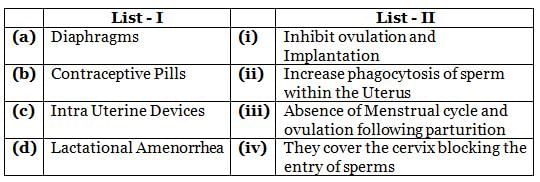Test: Reproductive Problems and Strategies - NEET MCQ
10 Questions MCQ Test - Test: Reproductive Problems and Strategies
The programs to get total reproductive health as a social goal at the national level are called
In case of a couple where the male is having a very low sperm count, which technique will be suitable for fertilisation?
Which of the following is the correct reason for delivering sex education at schools?
Tubectomy is a method of sterilisation in which
Emergency contraceptive methods must be employed within:
Match List - I with List - II with respect to methods of Contraception and their respective actions.

Choose the correct answer from the options given below:
How many of the following are indicators of improved reproductive health of society?
(a) More couples with larger families
(b) Better detection and cure of STIs
(c) Better post-natal care
(d) Increased number of medically assisted deliveries
(e) Increased IMR
What is the primary goal of the reproductive and child health care programs (RCH) currently in operation in India?
Assertion(A): Amniocentesis is banned for sex dertermination.
Reason(R): Amniocentesis gives information about foetal abnormalities.
Match Column I with Column II and choose the correct option:
Column I Column II
(a) Legalisation of MTP in India | (i) 2017
(b) Initiation of ‘family planning programs’ | (ii) 1971
(c) India’s population reached 1.2 billion | (iii) 2011
(d) MTP amendment act | (iv) 1951



















